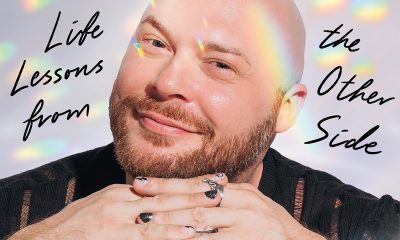National
New York Times called out for coverage of transgender people
GLAAD billboard circled newspaper’s Manhattan headquarters on Wednesday morning

In a one-two punch aimed directly at the New York Times; more than 100 contributing writers, fellow journalists, celebrities and advocacy organizations today joined GLAAD in demanding change in how the newspaper covers transgender issues and trans people.
First, GLAAD hired a billboard truck to circle the newspaper’s Manhattan headquarters this morning with signs saying, “Dear New York Times: Stop questioning trans people’s right to exist and access to medical care,” among other messages.
“I think what what’s most upsetting here is the damage this is doing,” Sarah Kate Ellis, GLAAD CEO and president of the world’s largest LGBTQ media advocacy organization, told the Washington Blade in her first phone interview on the topic Tuesday. “Every day they’re not stopping is doing more damage. Every time a new article comes out that debates whether or not trans people should receive board-approved healthcare is damaging. And so I feel really strongly that their coverage is dangerous.”
Then, to protest what GLAAD calls the Times’ “irresponsible, biased coverage of transgender people,” representatives of the organization joined contributors for the Times outside the paper’s building this morning, as they delivered two open letters and issued a joint statement, calling out a “pattern of inaccurate, harmful trans coverage.”
The coalition demands the Times immediately “stop printing biased, anti-trans stories,” meet with members and leaders in the trans community within two months, and within three months hire at least four trans writers and editors as full-time members of the Times staff.

Joining GLAAD are the Human Rights Campaign, PFLAG, the Transgender Law Center, Transgender Legal Defense and Education Fund, the Women’s March, director Judd Apatow, comedian Margaret Cho, actor Wilson Cruz, actresses Tommy Dorfman, Lena Dunham, Jameela Jamil, drag superstar Peppermint, activist Ashlee Marie Preston, Jeopardy! champion Amy Schneider, writer/director/actress Shakina, actress, Instagram influencer and stepmom to Zaya, Gabrielle Union-Wade, TV personality Jonathan Van Ness, activist Charlotte Clymer and more.
“This has been an effort at GLAAD for over a year now,” Ellis told the Blade. “We’ve had several off-the-record meetings with the New York Times to share with them our concerns about the coverage and the reporting that they’ve been doing on the trans community.”
But those concerns fell on deaf ears, said Ellis, and the conversations were unfruitful. “We wouldn’t be going out with a public letter in coalition if they were fruitful. You know, for us going public, it’s always the last resort.”
Times Journalists Speak Out
As GLAAD worked toward publishing its letter, the organization was contacted by Times contributors already in the process of composing their own. A core team of eight journalists collaborated to condemn what they called the newspaper’s anti-trans bias and the real-world impact of that transphobic coverage.
The authors are Times freelancers Harron Walker, Eric Thurm, who is also campaigns coordinator at the National Writers Union and a steering committee member of the Freelance Solidarity Project, Sean T. Collins, who is also a member and organizer of the Freelance Solidarity Project, Cecilia Gentili, a longtime trans activist, Jo Livingstone, Muna Mire, and Chris Randle, a member of the steering committee at the Freelance Solidarity Project.
They were joined by Olivia Aylmer, a member of the steering committee at the Freelance Solidarity Project who is not a freelancer for the Times.
Not only did other contributing writers sign-on, but so did journalism colleagues, both cisgender and trans, as well as members of the Trans Journalists Association.
“A diverse group of people came together to bring you this complaint,” they wrote. ”Some of us are trans, nonbinary, or gender nonconforming, and we resent the fact that our work, but not our person, is good enough for the paper of record. Some of us are cis, and we have seen those we love discover and fight for their true selves, often swimming upstream against currents of bigotry and pseudoscience fomented by the kind of coverage we here protest.”
Those signing that letter include Ashley P. Ford, Roxane Gay, Carmen Maria Machado Thomas Page McBee, Andrea Long Chu, Carmen Maria Machado, John Cameron Mitchell, Zach Stafford, Raquel Willis and Maia Monet, among others.
Their letter, addressed directly to Times Standards Editor Philip Corbett, calls out the country’s third most-read paper for executing what it says is “poor editorial judgment,” repeated lack of context in its reporting on trans issues and following “the lead of far-right hate groups in presenting gender diversity as a new controversy, warranting new, punitive legislation.”
“There is in fact an unethical bias against trans people and transnesss within its coverage of trans issues, by and large,” said Walker, one of the organizers of the contributors’ letter. “There is a pattern of bias, and it’s a violation of the standards own policy as laid out by the standards desk.”
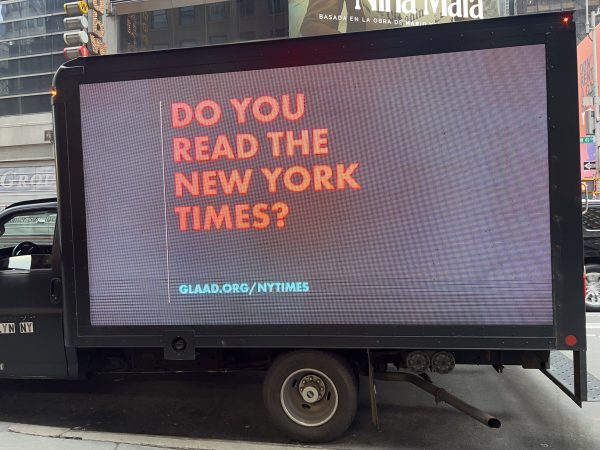
States that have seized upon this anti-trans reporting and opinion pieces by the Times include Alabama, Arkansas and Texas. Already, those states have joined Florida, Oklahoma, South Dakota, Tennessee and Utah in enacting discriminatory legislation.
Of these, Utah and South Dakota have passed healthcare bans that journalist Erin Reed calls “exceedingly cruel.” For example, South Dakota’s ban is one of those providing specific provisions on how to medically detransition trans teenagers, a practice now state law in Alabama and Arkansas.
“The New York Times coverage is feeding into defending these laws, by virtue of the fact that it’s the so-called paper of record,” Walker told the Blade. “It has one of the largest reaches of any newspaper in the world, it is respected. Even if people on the far right may dismiss it as the ‘failing New York Times,’ it still holds a legitimacy in a process that, you know, means something.”
‘Pattern of bias’
“Plenty of reporters at the Times cover trans issues fairly,” the contributing writers’ letter states. “Their work is eclipsed, however, by what one journalist has calculated as over 15,000 words of front-page Times coverage, debating the propriety of medical care for trans children published in the last eight months alone.”
GLAAD notes that officials in Texas quoted Emily Bazelon’s June 2022 report to go after families of trans youth in court documents over their private, evidence-based healthcare decisions.
Former Arkansas Attorney General Leslie Rutledge cited three Times articles in her amicus brief supporting an Alabama law that criminalizes doctors and parents for ensuring trans youth can access necessary medical care: Bazelon’s 2022 story, Azeen Ghorayshi’s January 2022 piece, and Ross Douthat’s April 2022 op-ed.
The Times’ reporting on trans youth and its reputation as the “paper of record” was cited just last week to justify a bill in a Nebraska legislative hearing, that would criminalize healthcare for trans youth.
Scores of other bills are in the works. Missouri Republicans are once again pushing for healthcare bans. Anti-trans bills in Montana, West Virginia and Mississippi have passed an entire chamber.
But by far the worst anti-transgender legislation and existing laws against the trans community are already on the books in Texas, which Reed calls “home to the weaponization of [Department of Protective Family Services] against transgender people.”
New restrictive bathroom laws are in place in Oklahoma, Alabama and Tennessee. Oklahoma’s healthcare ban restricts even adults, up to the age of 26, from accessing gender-affirming care. Florida has banned Medicaid coverage for trans-related healthcare for adults and is banning gender affirming care for trans teens. And as mentioned earlier, Utah, South Dakota, Arkansas and Alabama have targeted trans teens as well.
‘Britification’ of American media
For the most part over the last two decades, U.S. media had reliably shared a positive view of transgender people, especially youth, highlighting the stories of out trans celebrities like Chaz Bono, Laverne Cox, Caitlyn Jenner and Jazz Jennings. But since the Obergefell decision at the U.S. Supreme Court in 2015, trans people have become the religious right’s handy-dandy political boogeyman, to scare the flocks, rally the base and get out the vote. That’s a shift that was preceded by all-out negative coverage of trans issues in the U.K., where with rare exception the mainstream media is in lockstep with what is called the “Gender Critical” movement, opposing trans rights.
Ari Drennen is the LGBTQ program director for Media Matters, and has been tracking coverage of trans issues at the Times.
“I think it’s good to see people speaking up and talking about the really troubling pattern of coverage coming out of the Times, just because the Times is seen as the kind of gold standard for a lot of mainstream liberals,” Drennen told the Blade. “That pattern is especially notable at the Times. But there has been a sort of, you know, Britification, for lack of a better word, of the American media’s approach to trans people.”
Drennen cites a Reuters article from October about gender-affirming care for trans children that featured an extreme close-up photograph of a child wearing braces with a hormone pill on their tongue. “That was really just clearly intended to scare parents,” she said.
Also keeping a close watch on the Times and this Britification effect is Alejandra Caraballo, a clinical instructor at Harvard Law School’s Cyberlaw Clinic, where she works to advance the civil rights of LGBTQ people in a variety of civil legal contexts such as healthcare access, immigration and family law.
“In the U.K., the far right, particularly the religious far right, is almost a non-entity. They just don’t have the kind of cultural power and political power that they do in the United States,” Caraballo told the Blade, noting that the Gender Critical movement has taken a a more secular approach to its opposition to trans people, rather than a religious angle.
“In the United States, it’s always been the religious far right, but they are now trying to launder those narratives through these kind of secular outlets, to try to make it seem that the concerns aren’t just inherently based on religious ideology,” she said. “Part of it is this concerted strategy that I think a lot of the Gender Criticals have of particularly appealing to narratives that upper middle class white women would often be more amenable to, especially this idea that women have fought for rights, and somehow the existence of trans people is undermining those rights, because it’s hard to just oppose rights for people if it doesn’t impact you, so you have to create a sense of scarcity, and that’s what they do there. They say that ‘This is erasing women,’ ‘This is erasing women’s rights.’”
Racial bias
Caraballo noted that the people who are writing these stories at the Times are almost universally upper middle class, middle-aged white women, which speaks to the lack of racial diversity at the newspaper.
“I think what’s interesting is the kind of subject of every panic about over-medicalization in mainstream media tend to be white, and then the subject of the panic about kids and sports tend to be Black,” said Drennen. “I don’t need to have a Ph.D to see what’s going on.”
“I think part of it speaks to the lack of racial diversity,” echoed Caraballo. “I’m not surprised that one of the first really positive, outspoken editorials in the opinion column in the New York Times was by a Black man. I think there’s a sense of solidarity and understanding of how these things work, and I think when you have no trans people in the newsroom and no trans people as opinion columnists, and you have a newsroom that’s almost entirely stocked with a demographic that is particularly being targeted by Gender Criticals for pushing their views. I think it’s not a surprise.”
Anti-trans agenda
Caraballo said her conversations with people who work at the Times leads her to suspect this shift toward anti-trans narratives is not the writers or reporters themselves, but the result of an agenda set by their editors.
“For some people like Katie J.M. Baker, who has written extensively about how the media actually works to push transphobic narratives, to then write an article like she did about forcibly outing trans students, it just speaks to either opportunism, not really having a deeply-held belief about this, or just being pushed by the editors. I mean, this was her first major story,” she said. “I worry that what happens is the New York Times often times gives those kinds of views credibility. And you see this with the anti-trans people celebrating every one of these articles, because they view that they’re trans eliminationist and anti-trans positions are being laundered into the mainstream.”
Anti-trans tipping point
In 2014, Time Magazine put Laverne Cox on its cover and declared that trans Americans had achieved a tipping point in acceptance. But at the Times, a shift in who writes opinion pieces has tipped the balance the other way, noted Drennen.
“The New York Times has never been perfect in their coverage, of course. But over the last year, Jennifer Finney Boylan departed from the Times’s opinion section,” she said. While Boylan is still a freelancer for the Times, the bestselling author and scholar’s byline now regularly appears in the Washington Post.
“In the interim, they’ve added two incredibly anti-trans regular columnists, Pamela Paul and David French, the former lawyer for the anti-LGBTQ+ hate group, the Alliance Defending Freedom. This has a really troubling pattern of anti-trans sentiment. So, any perceived balance there was just got totally blown out the window over the last year.”
“I’m proud of the work I did for Times Opinion from 2007 to 2022, on hundreds of topics from presidential dogs to the history of the Negroni,” Boylan told the Blade. “As a freelancer, I felt lucky to have a regular slot on the page and was grateful for the trust the editors placed in me. I also wrote many essays about trans identity and trans politics, and was proud to be, for many years, the only ongoing voice on the page representing the wide range of trans identities. I am hoping all those stories put a human face to trans issues for readers of the Times, and opened some hearts.”
Boylan’s name does not appear alongside other Times freelancers in the open letter or the GLAAD letter, but ironically, the Times has been publishing her name in its Bestsellers list for 18 weeks in a row. Her novel, Mad Honey, co-written with Jodi Picoult, has yet to be reviewed in the newspaper or covered in any way, despite it being the most successful book co-written by any transgender person, ever. Is that more evidence of bias, or just a coincidence?
The science ‘debate’
“I am really disappointed that it’s come to this,” said Ellis. “The science is settled on transgender health care. As far as the New York Times is concerned, it is not settled science and they want to use their pages to debate it.”
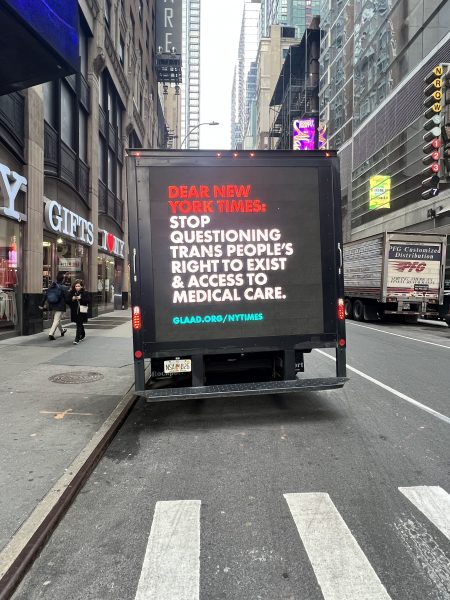
“It’s so dehumanizing,” added Caraballo, “because you have people debating your rights who have no stake in it whatsoever. They’re not the ones that are going to be denied healthcare. They’re not the ones who are going to be denied housing. They’re not the ones who are going to be kicked out of their homes when they’re forcibly outed to their parents. They have no stake in this. And that is particularly what’s so upsetting, to see all these people that literally will never feel the effects of these policies, constantly talking about how they have ‘concerns.’”
Will the Times agree to their demands?
Drennen said it’s hard to say whether these open letters will have any impact, because “so much of their decision-making is internal.”
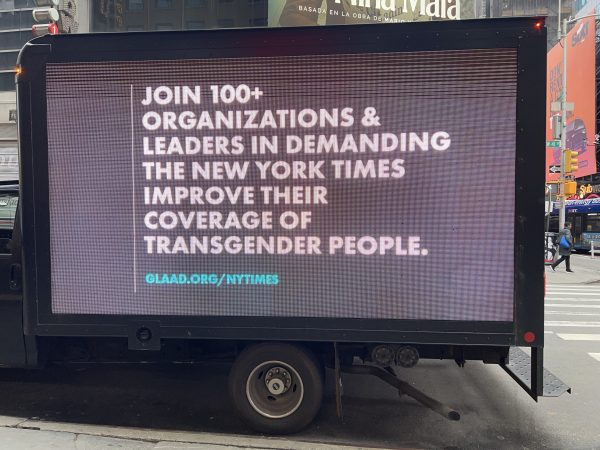
For her part, Walker said she remains excited by the coalition that’s been assembled and optimistic, but also realistic.
“Ideally what happens is the New York Times says, ‘Okay, yeah, let’s stop debating whether trans people should be allowed,’ and they start hiring a bunch of trans people. It’s the end of the story. I’m also realistic. I think it’s important to keep some idealism and some optimism in place and also realistic at the same time, which I also think is important. And I fully expect them to do their best to ignore it.”
“We’re too loud to ignore. If you ignore our letter, we’ll find some other way. If you ignore that, we’ll find another way,” Ellis said. “We’re not going to quit until the New York Times acknowledges our demands. And our demands are not outrageous. Within the letter, we’re just talking about stopping your irresponsible reporting, meeting with the trans community and hiring trans writers and editors. These are not outrageous demands that we’re making.”
Charlie Stadtlander, the director of external communications, newsroom, for the Times responded Wednesday afternoon in an email to the Blade addressing the controversy:
“We received the open letter delivered by GLAAD and welcome their feedback. We understand how GLAAD and the co-signers of the letter see our coverage. But at the same time, we recognize that GLAAD’s advocacy mission and the Times’s journalistic mission are different.
As a news organization, we pursue independent reporting on transgender issues that include profiling groundbreakers in the movement, challenges and prejudice faced by the community, and how society is grappling with debates about care.
The very news stories criticized in their letter reported deeply and empathetically on issues of care and well-being for trans teens and adults. Our journalism strives to explore, interrogate and reflect the experiences, ideas and debates in society — to help readers understand them. Our reporting did exactly that and we’re proud of it.”
Read the letters and who signed them by clicking here.
Federal Government
Holiday week brings setbacks for Trump-Vance trans agenda
Federal courts begin to deliver end-of-year responses to lawsuits involving federal transgender healthcare policy.

While many Americans took the week of Christmas to rest and relax, LGBTQ politics in the U.S. continued to shift. This week’s short recap of federal updates highlights two major blows to the Trump-Vance administration’s efforts to restrict gender-affirming care for minors.
19 states sue RFK Jr. to end gender-affirming care ban
New York Attorney General Letitia James announced on Tuesday that the NYAG’s office, along with 18 other states (and the District of Columbia), filed a lawsuit to stop U.S. Health and Human Services (HHS) Secretary Robert F. Kennedy Jr. from restricting gender-affirming care for minors.
In the press release, Attorney General James stressed that the push by the Trump-Vance administration’s crusade against the transgender community — specifically transgender youth — is a “clear overreach by the federal government” and relies on conservative and medically unvalidated practices to “punish providers who adhere to well-established, evidence-based care” that support gender-affirming care.
“At the core of this so-called declaration are real people: young people who need care, parents trying to support their children, and doctors who are simply following the best medical evidence available,” said Attorney General James. “Secretary Kennedy cannot unilaterally change medical standards by posting a document online, and no one should lose access to medically necessary health care because their federal government tried to interfere in decisions that belong in doctors’ offices. My office will always stand up for New Yorkers’ health, dignity, and right to make medical decisions free from intimidation.”
The lawsuit is a direct response to HHS’ Dec. 18 announcement that it will pursue regulatory changes that would make gender-affirming health care for transgender children more difficult, if not impossible, to access. It would also restrict federal funding for any hospital that does not comply with the directive. KFF, an independent source for health policy research, polling, and journalism, found that in 2023 federal funding covered nearly 45% of total spending on hospital care in the U.S.
The HHS directive stems directly from President Donald Trump’s Jan. 28 Executive Order, Protecting Children From Chemical and Surgical Mutilation, which formally establishes U.S. opposition to gender-affirming care and pledges to end federal funding for such treatments.
The American Medical Association, the nation’s largest and most influential physician organization, has repeatedly opposed measures like the one pushed by President Trump’s administration that restrict access to trans health care.
“The AMA supports public and private health insurance coverage for treatment of gender dysphoria and opposes the denial of health insurance based on sexual orientation or gender identity,” a statement on the AMA’s website reads. “Improving access to gender-affirming care is an important means of improving health outcomes for the transgender population.”
The lawsuit also names Oregon, Washington, California, Colorado, Connecticut, Delaware, the District of Columbia, Illinois, Maine, Maryland, Massachusetts, Michigan, Minnesota, New Mexico, Pennsylvania, Rhode Island, Vermont, and Wisconsin as having joined New York in the push against restricting gender-affirming care.
At the HHS news conference last Thursday, Jim O’Neill, deputy secretary of the department, asserted, “Men are men. Men can never become women. Women are women. Women can never become men.”
DOJ stopped from gaining health care records of trans youth
U.S. District Judge Cathy Bissoon blocked an attempt by the Department of Justice (DOJ) to gain “personally identifiable information about those minor transgender patients” from the University of Pittsburgh Medical Center (UPMC), saying the DOJ’s efforts “fly in the face of the Supreme Court.”
Journalist Chris Geidner originally reported the news on Dec. 25, highlighting that the Western District of Pennsylvania judge’s decision is a major blow to the Trump-Vance administration’s agenda to curtail transgender rights.
“[T]his Court joins the others in finding that the government’s demand for deeply private and personal patient information carries more than a whiff of ill intent,” Bissoon wrote in her ruling. “This is apparent from its rhetoric.”
Bissoon cited the DOJ’s “incendiary characterization” of trans youth care on the DOJ website as proof, which calls the practice politically motivated rather than medically sound and seeks to “…mutilate children in the service of a warped ideology.” This is despite the fact that a majority of gender-affirming care has nothing to do with surgery.
In United States v. Skrmetti, the Supreme Court ruled along party lines that states — namely Tennessee — have the right to pass legislation that can prohibit certain medical treatments for transgender minors, saying the law is not subject to heightened scrutiny under the Equal Protection Clause of the Fourteenth Amendment because it does not involve suspect categories like race, national origin, alienage, and religion, which would require the government to show the law serves a compelling interest and is narrowly tailored, sending decision-making power back to the states.
“The government cannot pick and choose the aspects of Skrmetti to honor, and which to ignore,” Judge Bissoon added.
The government argued unsuccessfully that the parents of the children whose records would have been made available to the DOJ “lacked standing” because the subpoena was directed at UPMC and that they did not respond in a timely manner. Bissoon rejected the timeliness argument in particular as “disingenuous.”
Bissoon, who was nominated to the bench by then-President Obama, is at least the fourth judge to reject the DOJ’s attempted intrusion into the health care of trans youth according to Geidner.
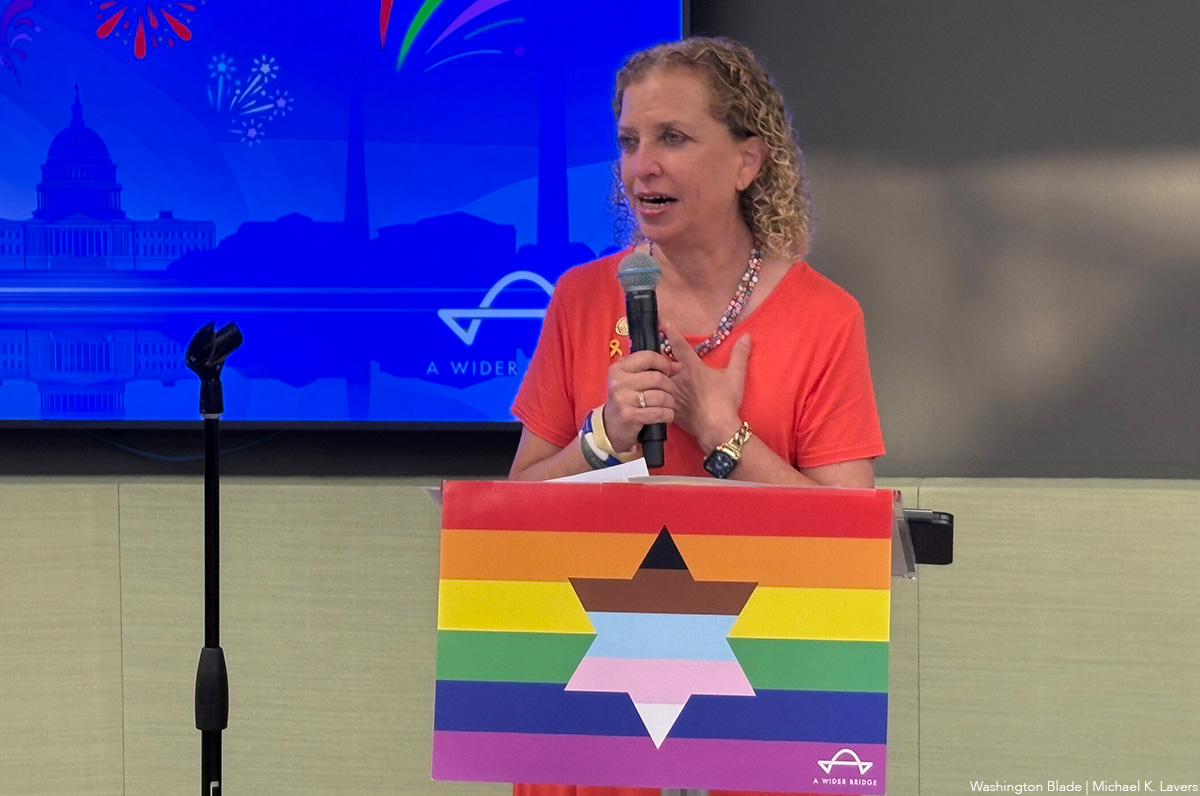
A Wider Bridge on Friday announced it will shut down at the end of the month.
The group that “mobilizes the LGBTQ community to fight antisemitism and support Israel and its LGBTQ community” in a letter to supporters said financial challenges prompted the decision.
“After 15 years of building bridges between LGBTQ communities in North America and Israel, A Wider Bridge has made the difficult decision to wind down operations as of Dec. 31, 2025,” it reads.
“This decision comes after challenging financial realities despite our best efforts to secure sustainable funding. We deeply appreciate our supporters and partners who made this work possible.”
Arthur Slepian founded A Wider Bridge in 2010.
The organization in 2016 organized a reception at the National LGBTQ Task Force’s Creating Change Conference in Chicago that was to have featured to Israeli activists. More than 200 people who protested against A Wider Bridge forced the event’s cancellation.
A Wider Bridge in 2024 urged the Capital Pride Alliance and other Pride organizers to ensure Jewish people can safely participate in their events in response to an increase in antisemitic attacks after Hamas militants attacked Israel on Oct. 7, 2023.
The Jewish Telegraphic Agency reported authorities in Vermont late last year charged Ethan Felson, who was A Wider Bridge’s then-executive director, with lewd and lascivious conduct after alleged sexual misconduct against a museum employee. Rabbi Denise Eger succeeded Felson as A Wider Bridge’s interim executive director.
A Wider Bridge in June honored U.S. Rep. Debbie Wasserman Schultz (D-Fla.) at its Pride event that took place at the Capital Jewish Museum in D.C. The event took place 15 days after a gunman killed two Israeli Embassy employees — Yaron Lischinsky and Sarah Milgrim — as they were leaving an event at the museum.
“Though we are winding down, this is not a time to back down. We recognize the deep importance of our mission and work amid attacks on Jewish people and LGBTQ people – and LGBTQ Jews at the intersection,” said A Wider Bridge in its letter. “Our board members remain committed to showing up in their individual capacities to represent queer Jews across diverse spaces — and we know our partners and supporters will continue to do the same.”
Editor’s note: Washington Blade International News Editor Michael K. Lavers traveled to Israel and Palestine with A Wider Bridge in 2016.
The White House
‘Trump Rx’ plan includes sharp cuts to HIV drug prices
President made announcement on Friday

President Donald Trump met with leaders from some of the world’s largest pharmaceutical companies at the White House on Friday to announce his new “Trump Rx” plan and outline efforts to reduce medication costs for Americans.
During the roughly 47-minute meeting in the Roosevelt Room, Trump detailed his administration’s efforts to cut prescription drug prices and make medications more affordable for U.S. patients.
“Starting next year, American drug prices will come down fast, furious, and will soon be among the lowest in the developed world,” Trump said during the meeting. “For decades, Americans have been forced to pay the highest prices in the world for prescription drugs by far … We will get the lowest price of anyone in the world.”
Trump signed an executive order in May directing his administration “to do everything in its power to slash prescription drug prices for Americans while getting other countries to pay more.”
“This represents the greatest victory for patient affordability in the history of American health care, by far, and every single American will benefit,” he added.
Several pharmaceutical executives stood behind the president during the announcement, including Sanofi CEO Paul Hudson, Novartis CEO Vas Narasimhan, Genentech CEO Ashley Magargee, Boehringer Ingelheim (USA) CEO Jean-Michel Boers, Gilead Sciences CEO Dan O’Day, Bristol Myers Squibb General Counsel Cari Gallman, GSK CEO Emma Walmsley, Merck CEO Robert Davis, and Amgen Executive Vice President Peter Griffith.
Also in attendance were Health and Human Services Secretary Robert F. Kennedy Jr., Commerce Secretary Howard Lutnick, Centers for Medicare and Medicaid Services Administrator Mehmet Oz, and Food and Drug Administration Commissioner Marty Makary.
Under the Trump Rx plan, the administration outlined a series of proposed drug price changes across multiple companies and therapeutic areas. Among them were reductions for Amgen’s cholesterol-lowering drug repatha from $573 to $239; Bristol Myers Squibb’s HIV medication reyataz from $1,449 to $217; Boehringer Ingelheim’s type 2 diabetes medication jentadueto from $525 to $55; Genentech’s flu medication xofluza from $168 to $50; and Gilead Sciences’ hepatitis C medication epclusa from $24,920 to $2,425.
Additional reductions included several GSK inhalers — such as the asthma inhaler advair diskus 500/50, from $265 to $89 — Merck’s diabetes medication januvia from $330 to $100, Novartis’ multiple sclerosis medication mayzent from $9,987 to $1,137, and Sanofi’s blood thinner plavix from $756 to $16. Sanofi insulin products would also be capped at $35 per month’s supply.
These prices, however, would only be available to patients who purchase medications directly through TrumpRx. According to the program’s website, TrumpRx “connects patients directly with the best prices, increasing transparency, and cutting out costly third-party markups.”
Kennedy spoke after Trump, thanking the president for efforts to lower pharmaceutical costs in the U.S., where evidence has shown that drug prices — including both brand-name and generic medications — are nearly 2.78 times higher than prices in comparable countries. According to the Pharmaceutical Research and Manufacturers of America, roughly half of every dollar spent on brand-name drugs goes to entities that play no role in their research, development, or manufacturing.
“This is affordability in action,” Kennedy said. “We are reversing that trend and making sure that Americans can afford to get the life-saving solutions.”
Gilead CEO Dan O’Day also spoke about how the restructuring of drug costs under TrumpRx, combined with emerging technologies, could help reduce HIV transmission — a virus that, if untreated, can progress to AIDS. The LGBTQ community remains disproportionately affected by HIV.
“Thank you, Mr. President — you and the administration,” O’Day said. “I think this objective of achieving the commitment to affordability and future innovation is extraordinary … We just recently launched a new medicine that’s only given twice a year to prevent HIV, and we’re working with Secretary Kennedy and his entire team, as well as the State Department, as a part of your strategy to support ending the epidemic during your term.
“I’ve never been more optimistic about the innovation that exists across these companies and the impact this could have on America’s health and economy,” he added.
Trump interjected, asking, “And that’s working well with HIV?”
“Yes,” O’Day replied.
“It’s a big event,” Trump said.
“It literally prevents HIV almost 100 percent given twice a year,” O’Day responded.
A similar anti-HIV medication is currently prescribed more than injectable form mentioned by O’Day. PrEP, is a medication regimen proven to significantly reduce HIV infection rates for people at high risk. Without insurance, brand-name Truvada can cost roughly $2,000 per month, while a generic version costs about $60 per month.
Even when medication prices are reduced, PrEP access carries additional costs, including clinic and laboratory fees, office visits, required HIV and sexually transmitted infection testing, adherence services and counseling, and outreach to potentially eligible patients and providers.
According to a 2022 study, the annual total cost per person for PrEP — including medication and required clinical and laboratory monitoring — is approximately $12,000 to $13,000 per year.
The TrumpRx federal platform website is now live at TrumpRx.gov, but the program is not slated to begin offering reduced drug prices until January.













